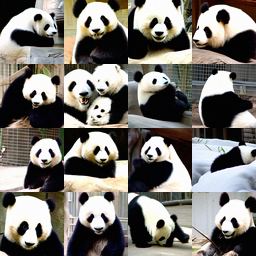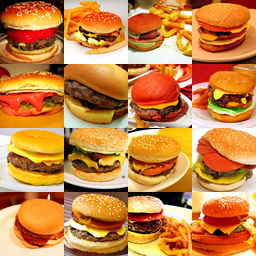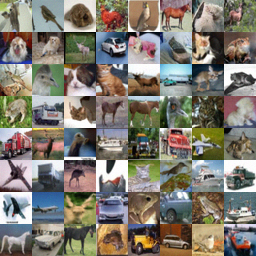This repo contains a PyTorch implementation for the paper Reflected Diffusion Models by Aaron Lou and Stefano Ermon, appearing at ICML 2023.
Requisite packages can be installed directly from the requirements.txt (note that this installs pytorch 2.0.1 with CUDA 11.7 enabled, but this can be downgraded based off of your requirements):
pip install -r requirements.txt
One can also manually install the packages torch, torchvision, scipy, hydra-core, and hydra-submitit-launcher through pip.
To download the pretrained models, simply run
sh download_pretrained.sh
This creates a weights folder with various model weights for CIFAR10 and ImageNet64. Each (main) model directory is of the form
├── model_directory
│ ├── .hydra
│ │ ├── config.yaml
│ ├── checkpoints
│ │ ├── checkpoint_*.pth
which is the minimum file structure that is needed for visualization and is generated by our training script.
We can visualize samples using
python run_vis.py load_dir=model_directory
where model_directory is a model directory as given above such as weights/cifar10 or weights/imagenet64. This creates a new directory direc=vis/DATE/TIME which outputs the images in the following directory structure
├── direc
│ ├── images
│ │ ├── *.png
│ │ ├── *.npz
Arguments can be added with ARG_NAME=ARG_VALUE. Interesting ones include
label imagenet class label (used with imagenet64 classifier-free guided model)
w guidance weight (used with imagenet64 classifier-free guided model)
sampling
method "pc" or "ode"
eval
rounds number of images to generate
batch_size batch size of generated images
For more information on imagenet class lables, reference this document. As an example, to generate 4 rounds of 16 images of pandas with guidance weight 2.5 using the ode, simply run
python run_vis.py load_dir=weights/imagenet64 label=388 w=2.5 sampling.method=ode eval.batch_size=16
Changing these hyperparameters results in outputs like the following:
To download the datasets used in the paper, simply run cd dataset and run the corresponding command:
python download_cifar10.py
sh download_imagenet32.sh
python compile_imagenet64.py /path/to/imagenet/
One can also add in new datasets by modifying the datasets.py file directly.
We can run training using the command
python run_train.py
This creates a new directory direc=runs/DATE/TIME with the following structure (compatible with running visualizations)
├── direc
│ ├── .hydra
│ │ ├── config.yaml
│ │ ├── ...
│ ├── checkpoints
│ │ ├── checkpoint_*.pth
│ ├── checkpoints-meta
│ │ ├── checkpoint.pth
│ ├── samples
│ │ ├── iter_*
│ │ │ ├── sample_*.png
│ │ │ ├── sample_*.npy
│ ├── logs
Here, checkpoints-meta is used for reloading the run following interruptions, samples contains generated images as the run progresses, and logs contains the run output. Arguments can be added with ARG_NAME=ARG_VALUE, with important ones being:
ngpus the number of gpus to use in training (using pytorch DDP)
model one of ddpmpp, vdm, adm, where adm is used with imagenet64c and ddpmpp and vdm are used otherwise.
* various args for the model
data one of cifar10, imagenet32, imagenet64c.
* various args for the data
training
batch_size training batch size
n_iters number of gradient updates
drop_label percentage of labels dropped during training (when using adm and imagenet64c)
sde
sigma_min minimum sde noise level. 0.01 is used for image generation while 0.0001 is used for likelihood results
optim
lr learning rate of the optimizer
The commands used for CIFAR10 image generation, CIFAR10 likelihood, ImageNet32 likelihood, and ImageNet64 image generation are respectively given below (on a 80GB gpu):
python train.py data=cifar10 model=ddpmpp
python train.py ngpus=4 data=cifar10 data.random_flip=False model=vdm training.n_iters=10000001 sde.sigma_min=0.0001
python train.py ngpus=8 data=imagenet32 model=vdm training.n_iters=2000001 training.batch_size=512 sde.sigma_min=0.0001
python train.py ngpus=8 data=imagenet64c model=adm training.n_iters=400001 training.batch_size=2048 optim.lr=1e-4
To run on slurm, simply uncomment the last few lines of configs/train.yaml or configs/vis.yaml and fill in your cluster details in place of null. Then, run the corresponding train/visualization commands with -m, e.g.
python run_train.py -m
@inproceedings{lou2023reflected,
title={Reflected Diffusion Models},
author={Aaron Lou and Stefano Ermon},
booktitle={International Conference on Machine Learning},
year={2023},
organization={PMLR}
}











